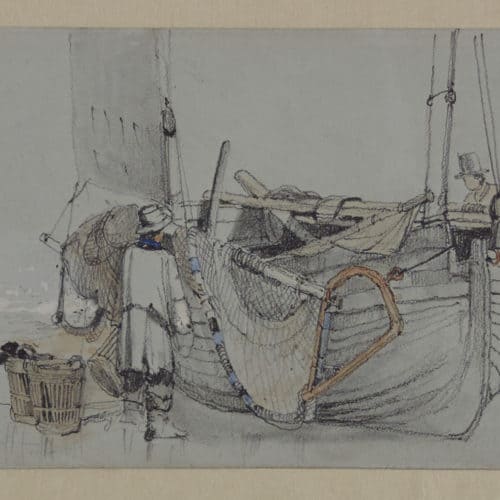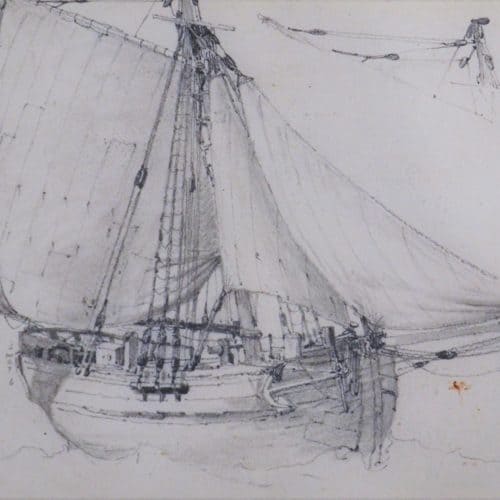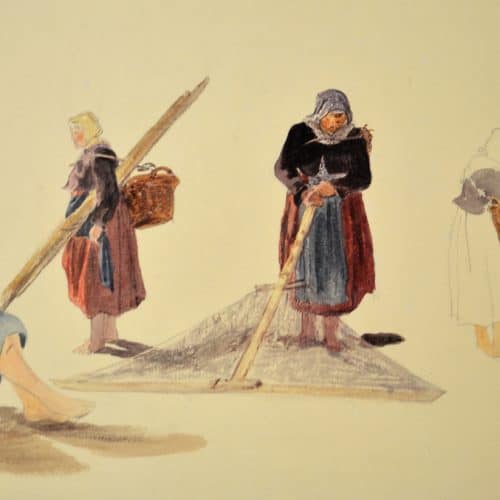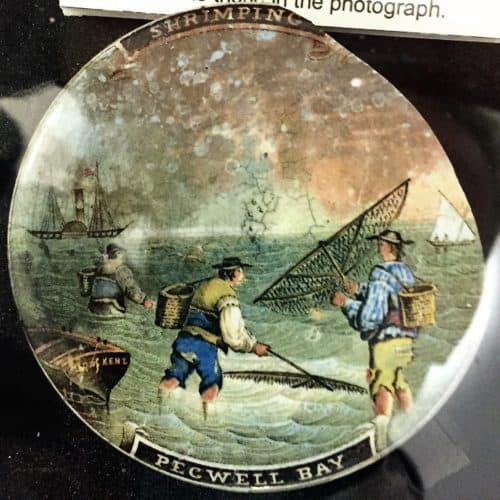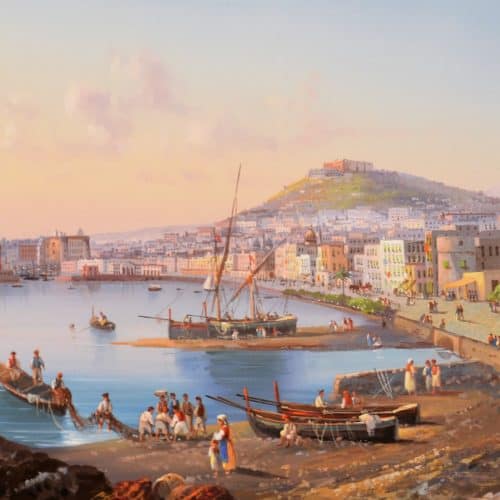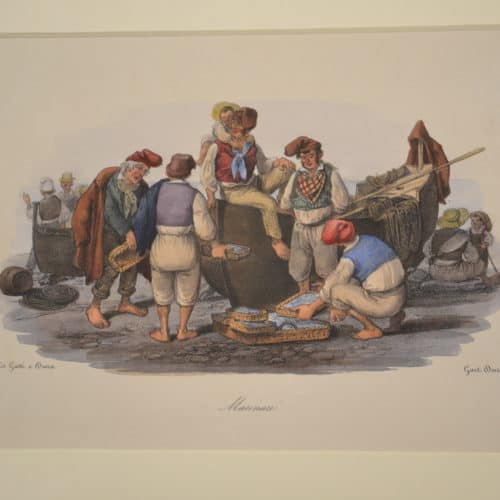Master Collection 5: fishing
Fishermen unloading their catch by Samuel Prout (1783-1852).
Pencil and watercolour heightened with white on blue paper.
These English fishermen (probably sketched at Hastings where Prout lived between 1837 and 1844) are wearing boots, trousers and overcoats, but also top hats!
- Do you think they wear the top hats while sailing or only after they land?
Their baskets probably contain fish they’ve just caught. These would be flatfish: plaice, halibut, flounder, sole or turbot.
The net they have on the boat is a beam trawl. It’s a large funnel-shaped net held open at the wide end by a wooden beam with hooped trawl heads, one of which we can see in this drawing.
When the trawl is dragged along near the seabed, a ‘tickler chain’ disturbs bottom-feeding flat fish and they get scooped into the net, accumulating in a bag or ‘codend’ at the funnel point.
Samuel Prout has drawn the beam trawl very accurately.
- Can you find the ‘tickler chain’ (with blue highlights)?
The fishing boat is also very accurately drawn.
- Can you see the way it’s built with overlapping planks?
This is known as ‘clinker built’, a boat-building method also used by Vikings and Anglo-Saxons.
The boat has a mast for the main sail, which has been taken down and stowed. A smaller sail is still raised. It has ‘tell tails’ (thin ties) hanging down. Tell tails stream when the boat is moving and tell the fishermen whether their sail is correctly positioned or ‘trimmed’.
Fascinating fact
Samuel Prout was one of the most admired artists of the early 19th century and became Painter in water-colours in Ordinary to both King George IV and Queen Victoria.
Lugger by Samuel Prout (1783-1852). Pencil on paper.
Probably sketched at Hastings where Prout lived between 1837 and 1844.
There are three sails on this lugger: a large one and two smaller triangular sails. The large one is a four-cornered ‘lug’ sail suspended from a boom or ‘yard’. This sail gives its name to the type of boat – ‘lugger’. It is the sail that powers the boat by wind.
All the sails have ‘tell tails’ – thin ties hanging down, which stream when the boat is moving and tell the fishermen if their sails are correctly positioned or ‘trimmed’.
The artist has drawn the rigging in more detail. He has focused on the ropes and blocks between the mast and yard.
All the rigging and sails are drawn very carefully.
- Can you see the blocks through which ropes run, for easier tightening and loosening?
The rigging includes rope laddering from the side to get up the mast.
The anchor is raised in the foreground. The boat is shown sailing, although we can’t see any crew.
Boulogne Fisherwomen by William Collins RA (1788-1847). Pencil and watercolour on yellow paper.
The women are holding shrimp nets - specially designed with a wide shallow bar at the front to sweep through shallow water and catch shrimps.
The shrimps are emptied into the large baskets, hung on a shoulder strap, as the women walk along.
The women are on a sandy beach in Boulogne, France (just over the Channel from Folkestone). They’ve got bare feet because shrimping is best done when the tide’s out leaving shallow pools of salt water in which the shrimps live.
Shrimping on beaches in northern France was mostly done by women, as the men were out on fishing boats. Hauling in a catch was more physically demanding and seen in Victorian times as men’s work.
Women shrimping while men fished, gave families two sources of income.
Shrimps were also an important food source for families.
From the 19th century factories made shrimp paste that was preserved by potting. People living far from the sea could eat potted shrimp.
It’s the lid of a small pot that shrimps were packed in for sale to the public. This example is from Pegwell Bay, near Ramsgate, Kent and dates from Victorian times.
- Can you spot the Victorian paddle steamer in the background?
Pot lids were often decorated with colourful transfer-printed pictures. This one shows shrimpers at work in Pegwell Bay.
Pegwell Bay has a wide shallow beach at low tide, ideal for shrimping. There was a potted shrimp factory nearby.
People ate the shrimps and often kept the lids as seaside holiday souvenirs!
Potted shrimp was a popular food in Victorian times and through much of the 20th century.
This painting of The Harbour, Naples is by the Italian artist Gioacchino La Pira (1839-1870).
The lighthouse is a tall slim structure at the far end of the harbour, in the distance on the left of the picture.
There are fishing nets drying on the left, in the foreground of the picture.
The buildings on top of the hill are a fortress and monastery.
The fortress, Castel Sant-Elmo, was built in the 14th century and enlarged in the 16th. Its principal aim was to discourage local revolt. Political prisoners used to be held there but it is now a museum.
The Monastery of San Martino beside it is of similar date and belonged to the Carthusian order.
- Can you feel the warmth of Naples air, conveyed by the artist through pinkish tone?
It feels like a balmy evening. Lots of people are strolling or gathered in small groups talking.
- How does the picture compare with Folkestone Harbour and The Leas promenade?
Pescatori by Gaetano Dura (1805-1878). Hand-coloured lithograph.
Pescatori is Italian for fishermen. These fishermen are in the Bay of Naples. We can see the active volcano Mount Vesuvius smoking behind them.
There are shellfish in the baskets. The brown ones on the right look like whelks or similar, the ones on the left like cockles.
The teeth on the net are for raking up the shellfish in shallow water or rock pools. As they are raked up, the shellfish are caught in the net and transferred to a basket.
The men on the right are basket-making. They have built a vertical structure of reeds and are then weaving reeds or straw in and out horizontally to build up a wall.
Basket forms have developed locally across the world to suit particular needs.
- What are the differences between the three baskets?
- What do you think the two in the middle are made from?
Marinari in Abito d’Inverno (Fishermen in winter clothes) by Gaetano Dura (1805-1878). Hand-coloured lithograph.
It’s winter in this image. Inverno is the Italian word for winter.
These fishermen from Naples are wearing thick hooded coats and hats.
Two men are wearing shoes but the rest are barefoot. Shoes were expensive and the fishermen could not afford them.
The two men wearing shoes must be boat owners or fish wholesalers. They also wear waistcoats.
The elderly woman on the left is wearing slippers and thick stockings.

